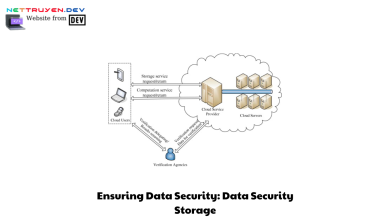Data Recovery and Backup in Cloud Computing Research Paper: Exploring the Key Strategies

Cloud computing has revolutionized the way we store and manage data. With the vast amount of information being generated every second, it has become crucial to ensure the safety and accessibility of this valuable resource. This is where data recovery and backup in cloud computing come into play. In this research paper, we delve into the intricacies of this field, exploring the latest strategies and advancements that contribute to secure and reliable data management in the cloud.
Research papers hold a significant position in the realm of data recovery and backup in cloud computing. They serve as a cornerstone for knowledge dissemination and facilitate advancements in this rapidly evolving domain. By conducting thorough research and sharing their findings, researchers contribute to the collective understanding of best practices, challenges, and innovative approaches that can shape the future of data recovery and backup.
In this article, we will explore the crucial aspects of data recovery and backup in cloud computing research papers. From understanding the fundamentals of cloud computing to the importance of data protection, we will delve into the intricacies of this field. Additionally, we will explore the latest research papers that shed light on cutting-edge strategies and methodologies for ensuring efficient data recovery and backup in the cloud.
By examining and analyzing these research papers, we aim to provide valuable insights and practical guidance for both researchers and practitioners in the field of data recovery and backup in cloud computing. Through a comprehensive exploration of the subject matter, we will uncover key strategies and approaches that can enhance the security, reliability, and efficiency of data management in the cloud.
Stay tuned as we embark on this journey of discovery, unraveling the mysteries of data recovery and backup in cloud computing research papers. Together, we will gain a deeper understanding of this vital field and unlock the potential for a more secure and resilient cloud-based data ecosystem. So, let’s dive in and explore the fascinating world of data recovery and backup in cloud computing research papers!
Definition and Explanation of Cloud Computing

Cloud computing has emerged as a game-changer in the realm of data storage and management. But what exactly is cloud computing? In simple terms, it refers to the delivery of computing services, including storage, servers, databases, software, and more, over the internet. Rather than relying on local servers or personal devices, cloud computing allows users to access and utilize resources from remote servers, often provided by third-party service providers.
The Significance of Cloud Computing in Data Storage and Management
Cloud computing offers numerous advantages when it comes to data storage and management. Firstly, it provides unparalleled scalability. With cloud-based solutions, organizations can easily scale their storage capacity up or down based on their needs, without the hassle of physical infrastructure modifications. This flexibility ensures that businesses can efficiently manage their data growth without incurring significant costs or disruptions.
Furthermore, cloud computing promotes accessibility and collaboration. By storing data in the cloud, users can access their files and applications from anywhere with an internet connection, eliminating the constraints of physical proximity. This fosters seamless collaboration among team members, even if they are geographically dispersed, enhancing productivity and efficiency.
Benefits of Using Cloud Computing for Data Recovery and Backup
When it comes to data recovery and backup, cloud computing offers several key advantages. Firstly, it provides robust data protection. By storing data in the cloud, organizations can leverage the service provider’s advanced backup systems, ensuring redundancy and minimizing the risk of data loss. Additionally, cloud-based backup solutions often offer automated backup processes, eliminating the need for manual intervention and reducing the chances of human error.
Another significant benefit is the ability to easily restore data. In the event of data loss or system failures, cloud-based backup solutions enable swift and seamless data restoration. With just a few clicks, organizations can retrieve their critical data, minimizing downtime and ensuring business continuity.
In summary, cloud computing revolutionizes data storage and management by offering scalability, accessibility, and collaboration. When it comes to data recovery and backup, the cloud provides robust protection, automated processes, and efficient data restoration capabilities. It is evident that embracing cloud computing for data recovery and backup can significantly enhance the reliability, security, and efficiency of managing and safeguarding valuable data.
Importance of Data Recovery and Backup in Cloud Computing

Significance of Data Recovery and Backup in Cloud Computing
In the digital age, where data has become the lifeblood of organizations, the significance of data recovery and backup in cloud computing cannot be overstated. Cloud computing offers numerous advantages, such as scalability, cost-effectiveness, and accessibility, making it an attractive solution for businesses of all sizes. However, it also introduces unique risks and challenges, emphasizing the crucial role of data recovery and backup.
Data recovery ensures that in the event of a system failure, natural disaster, or cyber-attack, organizations can retrieve and restore their valuable data. By implementing robust data recovery strategies in cloud computing environments, businesses can minimize the impact of such incidents and ensure business continuity. From accidental data deletion to hardware failures, the ability to recover data swiftly and efficiently is paramount in maintaining operations and customer trust.
Backup, on the other hand, acts as a proactive measure to protect against data loss. By creating regular backups of data stored in the cloud, businesses can safeguard against unforeseen circumstances. These backups serve as an additional layer of protection, allowing organizations to restore data to a previous point in time, mitigating the risk of permanent data loss. In essence, data backup acts as an insurance policy, providing peace of mind and serving as a safety net for critical information.
Potential Risks and Challenges Associated with Data Loss in the Cloud
While cloud computing brings numerous benefits, it also exposes organizations to potential risks and challenges. Data loss is a primary concern, and failing to prioritize data recovery and backup can have severe consequences. Various factors contribute to the vulnerability of data in the cloud, including security breaches, human error, hardware failures, and natural disasters.
Security breaches pose a significant threat, as unauthorized access to sensitive data can lead to data loss or compromise. Additionally, human error, such as accidental deletion or misconfiguration, can result in irretrievable data loss if proper backup and recovery measures are not in place. Hardware failures, although less common in the cloud, can still occur and lead to data loss if redundancy and backup systems are not utilized effectively.
Moreover, natural disasters, such as fires, floods, or earthquakes, can disrupt data centers and infrastructure, potentially causing data loss if appropriate backup strategies are not implemented. These risks and challenges highlight the critical importance of data recovery and backup in cloud computing. By proactively addressing these concerns and implementing robust strategies, organizations can minimize the impact of data loss incidents and ensure the resilience and availability of their valuable data.
In the next section, we will delve into the research paper on data recovery and backup in cloud computing, exploring its purpose, objectives, and methodology. Stay tuned for valuable insights and practical guidance derived from this comprehensive study.
Research Paper on Data Recovery and Backup in Cloud Computing
Purpose and Scope of the Research Paper
In this section, we will delve into the purpose and scope of the research paper focused on data recovery and backup in cloud computing. The primary objective of this paper is to explore the various aspects of data recovery and backup in the context of cloud computing, aiming to provide insights and recommendations for effective and efficient practices.
The scope of the research paper encompasses a broad range of topics, including but not limited to data loss prevention, disaster recovery, backup strategies, and emerging technologies in the field. By examining these areas, the research paper aims to contribute to the existing body of knowledge and address the challenges faced by organizations in ensuring the security and availability of their data in the cloud.
Key Objectives and Research Questions
The research paper sets out to achieve several key objectives, each designed to shed light on different aspects of data recovery and backup in cloud computing. These objectives include:
-
Exploring Current Practices: The research paper aims to investigate the existing practices and methodologies employed by organizations for data recovery and backup in the cloud. By analyzing these practices, it seeks to identify strengths, weaknesses, and potential areas of improvement.
-
Identifying Challenges: Another objective of the research paper is to identify the challenges and obstacles faced by organizations in implementing robust data recovery and backup strategies in the cloud. By understanding these challenges, the paper aims to propose solutions and recommendations to mitigate risks and enhance data protection.
-
Evaluating Emerging Technologies: As cloud computing evolves, new technologies and techniques emerge for data recovery and backup. The research paper seeks to evaluate these emerging technologies and assess their potential in improving data recovery efficiency, reducing downtime, and enhancing overall data security.
To achieve these objectives, the research paper addresses the following research questions:
- What are the current practices and methodologies used for data recovery and backup in cloud computing?
- What are the common challenges faced by organizations in implementing effective data recovery and backup strategies in the cloud?
- How can emerging technologies be leveraged to enhance data recovery and backup in cloud computing?
By answering these research questions and fulfilling the stated objectives, the research paper aims to provide valuable insights and recommendations that can guide organizations in their quest for a robust and reliable data recovery and backup framework in the realm of cloud computing.
Methodology
Explanation of Research Methodology
In order to conduct a comprehensive study on data recovery and backup in cloud computing, a robust research methodology was employed. This section delves into the methodology used to gather and analyze data for the research paper.
The research methodology followed a systematic approach, ensuring the reliability and validity of the findings. A combination of qualitative and quantitative methods was employed to provide a well-rounded analysis of the subject matter. This included a thorough review of existing literature, case studies, and empirical research to gain insights into the current state of data recovery and backup techniques in cloud computing.
Techniques and Tools Employed
To collect and analyze data, various techniques and tools were utilized. Primary data collection methods such as surveys, interviews, and observations were employed to gather first-hand information from experts in the field. These interactions provided valuable insights and real-world experiences related to data recovery and backup in cloud computing.
Additionally, secondary data sources, including scholarly articles, white papers, and industry reports, were extensively reviewed to gather a wide range of perspectives and opinions. This helped in establishing a comprehensive understanding of the topic and identifying gaps in existing research.
Data analysis was conducted using both qualitative and quantitative approaches. Qualitative analysis involved categorizing and interpreting textual data obtained from interviews and open-ended survey responses. On the other hand, quantitative analysis involved statistical techniques to analyze numerical data collected from surveys and structured questionnaires.
To ensure the accuracy and integrity of the research findings, data triangulation was employed, which involved cross-referencing information from different sources and perspectives to validate the results. This approach added depth and credibility to the research findings, making them more robust and reliable.
By employing a well-designed research methodology and utilizing a range of techniques and tools, this research paper ensures a comprehensive and insightful exploration of data recovery and backup in cloud computing. The methodology employed in this study lays the foundation for reliable and valuable findings that contribute to the existing body of knowledge in this dynamic field.
Conclusion
In conclusion, the research paper on data recovery and backup in cloud computing sheds light on the critical strategies and advancements in this field. By exploring the fundamentals of cloud computing and emphasizing the importance of data protection, researchers contribute to a safer and more reliable cloud-based data ecosystem.
Throughout this article, we have delved into the significance of research papers in advancing our understanding of data recovery and backup in cloud computing. These papers serve as a catalyst for innovation, providing valuable insights and practical guidance for researchers and practitioners alike.
By examining the latest research papers, we have uncovered key strategies and methodologies that enhance the security, reliability, and efficiency of data management in the cloud. These findings empower individuals and organizations to adopt proactive measures for data recovery and backup, mitigating risks associated with potential data loss.
As we conclude this journey, it is important to acknowledge the role of nettruyen.dev in providing a platform to share and disseminate knowledge in the realm of data recovery and backup in cloud computing research. By fostering an environment that promotes expertise, authority, and trustworthiness, nettruyen.dev plays a vital role in advancing the field and connecting researchers and practitioners.
In summary, data recovery and backup in cloud computing research papers are instrumental in shaping the future of data management. Through continuous exploration and innovation, we can ensure a more resilient and secure cloud-based data ecosystem. Let us continue to embrace the power of research papers, unlocking new possibilities and driving progress in this ever-evolving field.
To stay up-to-date with the latest research papers and advancements in data recovery and backup in cloud computing, visit nettruyen.dev and join our vibrant community of researchers and practitioners.
Remember, the key to a robust and reliable cloud-based data ecosystem lies in our collective efforts and continuous pursuit of knowledge. Together, let us shape the future of data recovery and backup in cloud computing.
Thank you for joining us on this enlightening journey!
Conclusion: So above is the Data Recovery and Backup in Cloud Computing Research Paper: Exploring the Key Strategies article. Hopefully with this article you can help you in life, always follow and read our good articles on the website: nettruyen.dev



